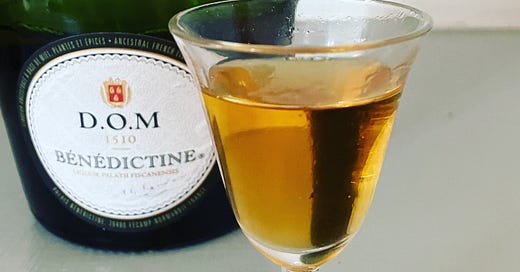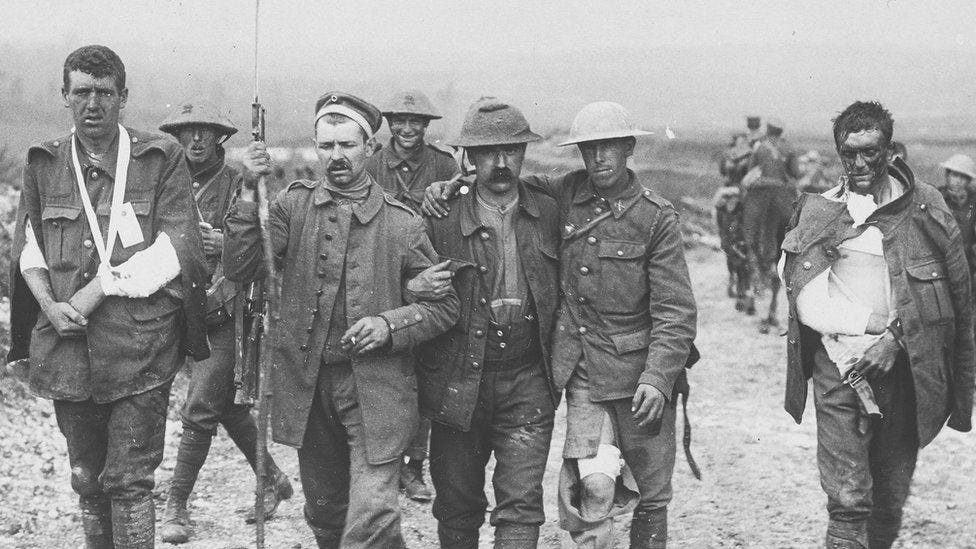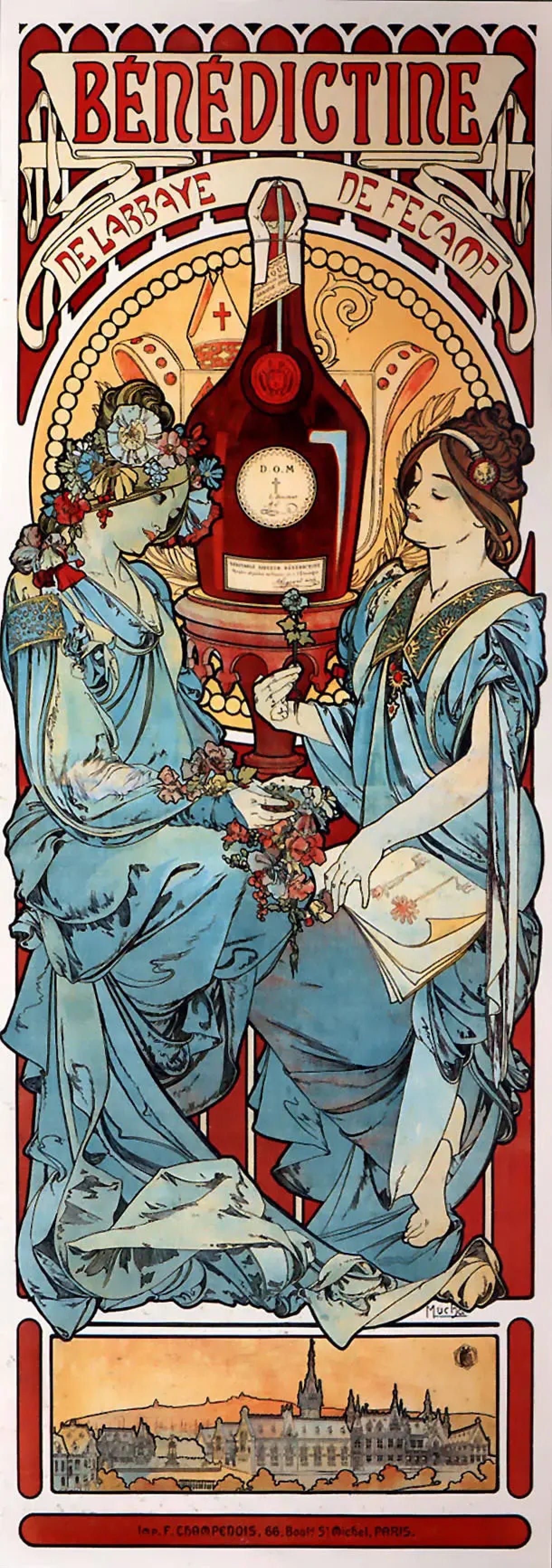NOTE! I am revisiting some old classics from the Spirits vaults over the summer. While I was down in there cellar, I figured I may as well open up a few bottles from the Cabinet too. Over the next couple of weeks - on Tuesday at 4pm - I’ll re-send out a few of these in-depth guides MINUS THE PAYWALL for a limited time. The Bénédictine entry was one of my favourites to research and it’s just such a delicious liqueur too. Should you wish to read more like this, well, you know what to do.
~ BÉNÉDICTINE ~
Herbal liqueur / 40% ABV / c.£30 for 700ml
Friends with: dark spirits, notably brandy, bourbon and rye. Italian vermouth. Absinthe. Peychaud’s bitters. Also, gin, French vermouth, sherry. And, cream, chocolate, coffee, etc.
Imagine, you are a teenager in a northern English industrial town in 1914. The ruling classes of Europe have resolved to see how many of you they can annihilate in order to satisfy one of their most inscrutable codes of honour. The army turns up in the market square one day and the recruiting sergeant gives you a rousing blast of King and Country, valour and duty - the whole shooting match. Sounds fun. You sign up. And so do all of your friends. Only to discover that what you have signed up for is gas, schrapnel, mud, rats, blood, pain, madness - the “most colossal, murderous, mismanaged butchery that has ever taken place on earth”, as Hemingway had it.
One of the most famous stories of mass conscription in the First World War concerns the “Accrington Pals” - almost the entire cohort of young, fit and able men of that Lancashire town, who formed most of the 11th Batallion of the East Lancashire Regiment. This was to be the unlucky team that led the charge at Serre in the first Battle of the Somme in 1916, man after man, walking out of the trenches into the sights of the German machine gunners who couldn’t believe how dim the English were being. We continued to send men over the top, long after it was clear that the tactic was a disaster. But in the words of one English Brigadier-General:
“The lines which advanced in such admirable order, melted away under fire; yet not a man wavered, broke the ranks or attempted to go back. I have never seen, indeed could never have imagined such a magnificent display of gallantry, discipline and determination."
Out of 720 Accrington Pals, 584 didn’t make it back. We can be grateful for many things in 2023 2024, but I think the fact we don’t regard the sight of hundreds of young men marching senselessly to their deaths as “magnificent” is probably one of them.
But OK, let’s imagine you’re one of the lucky ones. You’re from nearby Burnley. You’re in the 5th Battalion. You’re shot in the neck. You spend the night in a shell-hole, watching as rats begin work on the corpse of a guy who once went took your sister the cinema, listening to the rattles and pffts and blasts of death. But the stretcher-bearers find you in the mists of the morning and… “Cheer up, lad, we’ll soon have you out of there!”
You are now recovering from your wounds in a hospital behind the lines in Fécamp, on the coast of Normandy, haunted and shattered. A French nurse, buttery and celestial, hands you a cup. It containeth Bénédictine, D.O.M., a liqueur made by the local monks as an act of silent devotion to the Lord. You put the cup to your lips and hallelujah! It is the sweet taste of salvation.
Or as Private Archy Wilson wrote to his wife, Clementine:
"Our nurse brought round a very nice drink with hot water in it called Benedictine. It warmed my heart. Lads of the 5 E Lancs Batt’ are in my ward and they all drink it.”
Now: would you believe that to this day, the largest single consumer of Bénédictine D.O.M. is not some fancy Parisian hotel nor some hip New York speakeasy but The Burnley Miners Social Club? It’s true. Many thousands of East Lancashire men passed through Fécamp in the First World War and they brought back with them a taste for the local liqueur. Some of them apparently even had a Christmas party at the Palais Bénédictine in 1917. “Benny and Hot” is the preferred serve: quite simply 50ml of Bénédictine topped with 100ml hot water. (This is known as a foutinette in France). You can even get it at Turf Moor, the local football ground. “It’s an emotional thing,” said Burnley’s head of hospitality in this insightful FT piece. “It’s almost a rite of passage for a true Burnley supporter. Everyone remembers their first game at Turf Moor; everyone remembers their first Bene.”
Taste Bénédictine and it really does seem like the liquid to warm the cockles of an exhausted Tommy. (Or, indeed, a Burnley supporter after a discouraging 5-2 home defeat). It is immediately comforting: metallic sugar, kingly spice, medicinal but in a nurturing, Mary Poppins sort of way, redolent of clean sheets, a warm fire, old friends and golden sickles. And it is a little celestial, too, having been made by Bénédictine monks - the silent type - since at least 1510 at the Abbey of Fécamp. I can imagine these monks in their cloister, hearing the shell fire, shaking their heads at one another and proceeding with their maceration. Whatever the opposite of war is, that’s what Bénédictine is tastes like.
So what is it? Well, neutral spirit, sweetened with sugar, and macerated and distilled with a secret blend of 27 herbs, roots and spices over a four-part process and then aged. That’s quite a process. And quite a recipe - the precise combination of herbs is (like its bar-mate, Chartreuse) a secret, known only to a mysterious “master herbalist” who for all we know, may be the Lord himself. Although it should be noted, in the interests of pedantry, that the modern Bénédictine recipe was actually formulated in 1863 by a Fécamp merchant named Alexandre le Grand.
Le Grand was apparently quite the entrepreneur - opening up the Palais Bénédictine as a tourist attraction, petitioning the pope himself for permission to use all the holy branding, and perpetuating the story that he had found the 1510 recipe amid the alchemical equipment in some dusty gothic attic - rather as Thomas Chatterton (below) claimed to have found his medieaval masterpieces in St Mary Redcliffe. And the story worked. Bénédictine soon found its way into all respectable establishments and many respectable cocktails, too. And for a dozen of these you will have to read on.
CABINET POSTS YOU MAY HAVE MISSED:
🐿️ Amaretto
🧡 Aperol
🍑 Apricot Brandy
🕊️ Bénédictine
❄️ Brancamenta
🍌 Crème de Banane
🍫 Crème de Cacao
🫐 Crème de Cassis
🌷 Cynar
🌸Elderflower Liqueur
🏝️ Falernum
🦅 Fernet-Branca
🌿 Green Chartreuse
🐻 Kümmel
🍒 Maraschino
🌵 Mezcal
🦙 Pisco
🐂 Sherry
🌻 Suze
A GENERAL INTRODUCTORY NOTE
I tend to think of Bénédictine as part of a loose family of sweet liqueurs along with the darker kind of crème de cacao, coffee liqueur, Cuaranta y Tres and Drambuie. (Drambuie is to Scotch as Bénédictine is to Brandy). It’s not a million miles away either from the sweeter amaros like Amaro di Montenegro and non-Italian equivalents like Becherovka (Czech), Unicum (Hungary) and, yes, Jägermeister (Germany), though not nearly as bitter. So, by all means experiment with Bénédictine as a substitute for any of the above. For example, as the cacao element in a Brandy Alexander? Or the coffee element in a Daiquiri Mulata? Or maybe even the Jägermeister element in a Jägerbomb? On the menu at the Burnley Miners Social Club.
But if you’re new to Bénédictine, you could do a lot worse than follow those old school miners and make yourself a BÉNÉ & HOT aka La Foutinette: one part liqueur to two parts hot water. (I note that Simon Difford suggests jasmine tea as a mixer).
And actually, there is a classic and childishly simple mixed drink to make with it too: the B & B, quite simply Brandy and Bénédictine. The combination became so popular in the 1930s that Bénédictine started selling its own pre-bottled B&B, an early example of a ready-to-drink cocktail. The ‘house’ proportions are 60% Bénédictine, 40% brandy but I’d aim for more like two parts brandy to one part Bénédictine if you’re mixing yourself. Serve it on the rocks if you like - but I happen to think this is a combination that’s good at room temperature. In fact, I can remember once ending a long and langurous dinner by placing a bottle of each on the table and letting everyone pour their own B & B for them themselves. Watch the hangover, mind.
THE STIRRED
If you tuned in last week, you will be familiar with the CHRYSANTHEMUM, a dainty ‘shim’ (low-alcohol cocktail) in which Bénédictine provides the anchor. I like the version in Dinah Saunders’s book The Art of the Shim. 45 French vermouth, 15ml Bénédictine, 2.5ml absinthe, served up and garnished with an orange twist. You might top it with champagne too, she suggests.
Bénédictine also takes the Martini in an interesting direction. Sometimes this is known as The Ford, though I prefer the name The POET’S DREAM. I can remember being served one of these in the Varnish in L.A. once when I asked for a twist on a Martini. 50ml gin, 15ml vermouth, 5ml Bénédictine, served up with a twist. Stir well friends, stir well.
A chouïa (5-10ml) of Bénédictine rarely fails to life Manhattan/Old Fashioned-type cocktails. These are serious, brooding, thumpingly alcoholic drinks, the type that you will see young men with Peaky Blinders haircuts cradling uncertainly on Tinder dates. The VIEUX CARRÉ is the king of such cocktails, created by Walter Bergeron at the Monteleone Hotel in New Orleans in 1937. Stir: 25ml rye (or bourbon), 25ml brandy, 25ml Italian vermouth, 5ml Bénédictine and a dash each of Angostura and Peychaud’s bitters. In the same spirit of excess, garnish with a lemon twist and a maraschino cherry. You’ll generally see this served on the rocks but straining it into a cocktail glass is good too.
The Vieux Carré has a cousin, the LOUISIANA (often called ‘Cocktail a la Louisiane’ as it’s from the Restaurant de la Louisiane). This one gives more of a starring role to the Bénédictine and it comes out a lot sweeter: 25ml rye (or bourbon), 25ml Italian vermouth, 25ml Bénédictine, generous dash of absinthe, generous dash of Peychaud’s bitters.
These are fairly serious, boozy cocktails. Now do you want something still more serious, still boozier? OK how about a PURGATORY? Created by Ted Kilgore in 2007, the original specs were something like 75ml rye, 20ml Bénédictine, 20ml green Chartreuse. But I would halve that, frankly, and maybe even add a little cold water to dilute. Ooh, it’s nice though! Kilgore was possibly inspired by the WIDOW’S KISS which calls for the other kind of Chatreuse and is a slightly better cocktail in my opinion. 40ml calvados/apple brandy, 10ml Bénédictine, 10ml yellow Chartreuse, dash Angostura.
Remember how I compared Bénédictine to Drambuie? Well, it’s a useful sub if you don’t feel like splashing out on both bottles and is called for by name in the classic Scotch cocktail, the BOBBY BURNS (below!). I’d go with Frank Caiafa’s recipe: 50ml Scotch, 25ml Italian vermouth, 5ml Bénédictine and a dash of absinthe. Served up with a lemon twist. And maybe a shortbread cookie.
THE SHAKEN
While Bénédictine’s natural home is in rich, after-dinner stirred drinks, sometimes (like its fellow monkish liqueur, Chartreuse), it likes to let its hair down. As in the LANI-HONI, a semi-classic tiki drink from the SS Mariposa. Shake 45ml Bénédictine, 30ml light rum, 15ml lemon juice and served in a goblet filled with crushed ice. According to Jeff Berry, this was served upon the SS Mariposa on its 42-day South Seas cruise, circa 1962. They must have got through a lot of Béné.
On my own little cruise among the dusty tomes of cocktails past - namely the UK Bartenders Guild, 1937 - I was intrigued to come across a vintage drink called the DAILY MAIL named after that much-loved bastion of British common sense, moral consistency and celebrities flaunting their curves. Shake: 30ml gin, 15ml Bénédictine, 15ml lemon juice, with a dash curaçao and a dash of Angostura. Curiously, the same volume also turns up THE SUN (30ml brandy and 15ml dark rum, stirred with 5ml sugar syrup and dashes of Bénédictine, curaçao and crème de rose over crushed ice) and THE NEW YORK HERALD (a truly insane drink: 40ml brandy, 20ml kirsch, 10ml curacao, 10ml maraschino, 10ml crème de rose, dash Benedictine, dash crème de cacao, 10ml pineapple juice, 80ml orange juice, 80ml cream and one egg yolk. Topped with the whisked egg white). Was there something about the presence of Bénédictine in a drink that made it newspaperly? Is there some secret history here? I have no idea. The past is full of mysteries.
And here is another Bénédictine curio: THE GARDEN OF ALLAH, named after the notoriously louche Hollywood hotel (above) that once stood opposite Chateau Marmont, where you might run into Greta Garbo, Errol Flynn, Frank Sinatra, Marilyn Monroe, Sergei Rachmaninov, Ronald Reagan and F. Scott Fitzgerald, possibly nude, probably not at the same time. To make the house cocktail: do a reverse double-shake with 30ml cream, 15ml Bénédictine, 15ml crème de cacao, a dash of absinthe and, oof, 15ml egg white. Strain and serve up. And to tie things up quite neatly, here is an enjoyable romp through Garden of Allah history from… the Daily Mail. “Every hour was cocktail hour”.
Then there is the PANTHEON, the subject of a recent stand alone post. It was created by the Japanese bartender Daisuke Ito and it’s 40ml Scotch, 20ml lemon juice, 20ml of the Bé. And what a sensational drink it is.
THE LONG
I feel we need a fanfare. Because I have saved the best until last. The SINGAPORE SLING! Yhis one will be worth a decent-length post all of its own one day. There are many BAD Singapore Slings, including by all accounts the one served at the Raffles Hotel in Singapore. But the OG recipe by Ngiam Ton Boom (referenced in Lawrence Osborne’s On Java Road, below). cannot be beaten. Shake: 45ml gin, 15ml cherry brandy, 10ml Bénédictine, 20ml lemon juice, 15ml sugar syrup and a dash of Angostura bitters. Strain into a tall glass filled with ice and top with approximately 60ml fizzy water. Lemon slice to garnish. Praise the lord.
Next time: Cachaca












When I was on vacation in Normandy last year I visited the distillery in Fécamp. I learned that Bénédictine was so popular that a lot of other distilleries created counterfeits with similar branding. Apparently Alexander Legrande was one of the first businessman to internationally patent bottle design trademarks and aggressively prosecute against knock offs.